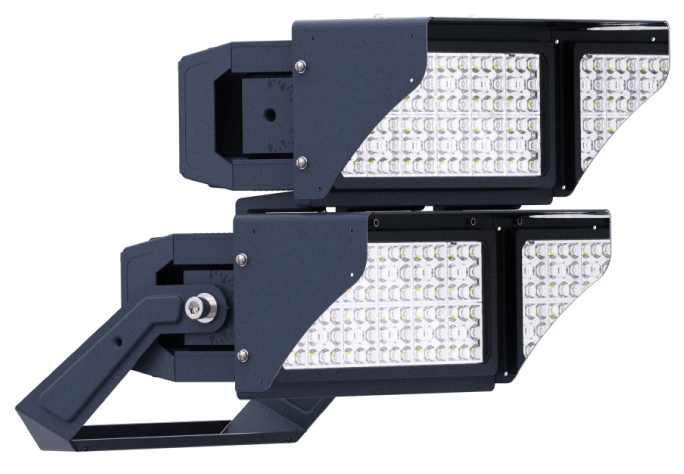Led Sports Hall Lighting
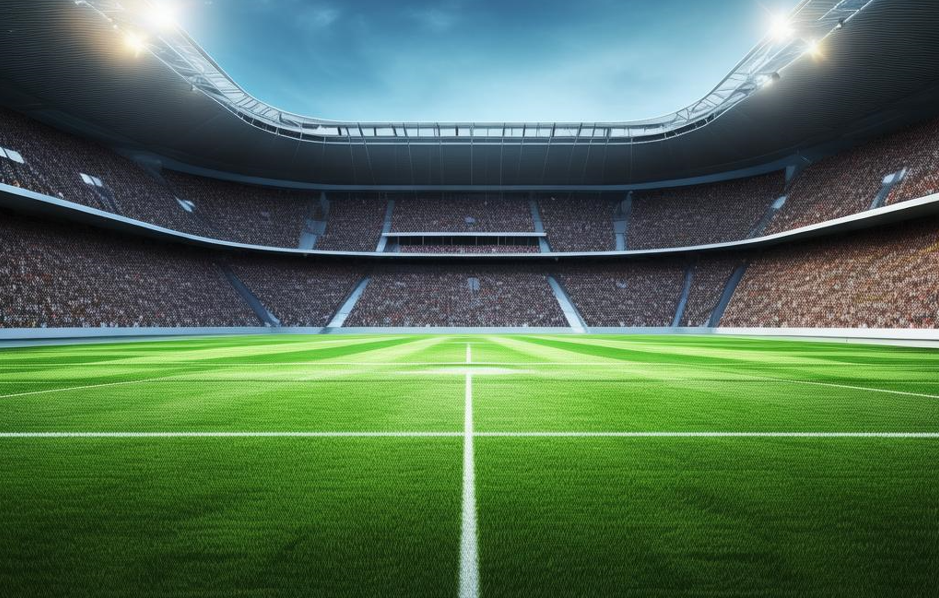
Directory:
1. Sports Hall Lighting Requirements
2. Sports Hall Lighting Fixture Requirements
3. Utilization Factor of Sports Hall Lighting
4. Enhance Sports Hall lighting Lighting Design
In recent years, stadiums have experienced positive growth. As these venues develop, the quality of their lighting has consistently improved, and the industry is showing strong momentum. Additionally, in light of the "double carbon" goal, there is a new focus on making sports facilities greener, more energy-efficient, and environmentally friendly. The high energy consumption associated with sports hall lighting has long been a challenge in lighting design, making it essential to enhance energy efficiency in this area.
1. Sports Hall Lighting Requirements
Stadiums are primarily designed for sports and competitions, such as track and field and football. Because various factors like space, range, direction, and speed affect sports, the lighting requirements for these venues are more stringent than for standard lighting. Sports hall lighting must provide high illumination, uniformity, excellent color rendering, and minimal glare, necessitating the use of specialized lighting fixtures and techniques.
2. Sports Hall Lighting Fixture Requirements
Sports hall lighting must cover large areas, project over long distances, and offer precise control. Typically, high-efficiency floodlights are used, with a preference for high-power metal halide or LED lamps.
Recently, high-power LED lamps have gained popularity due to their superior luminous efficacy, functionality, and starting characteristics compared to metal halide lamps. However, LED lamps tend to produce higher central light intensity and more glare. Therefore, managing glare and improving the utilization of sports hall lighting is crucial.
3. Utilization Factor of Sports Hall Lighting
3.1 Definition
The utilization factor is the ratio of the luminous flux that reaches a reference plane to the total luminous flux of the light source in the lighting fixture.
3.2 Calculation of Utilization Coefficient for Large Area Floodlights
For large area floodlights, the utilization coefficient refers to the percentage of luminous flux from the light source that reaches the working surface. To simplify calculations, this coefficient can be determined from Table 1 based on the ratio of floodlights whose luminous flux fully illuminates the surface (beams A and B in Figure 1) to the total number of floodlights.
Fig.1 Luminaire utilization factor
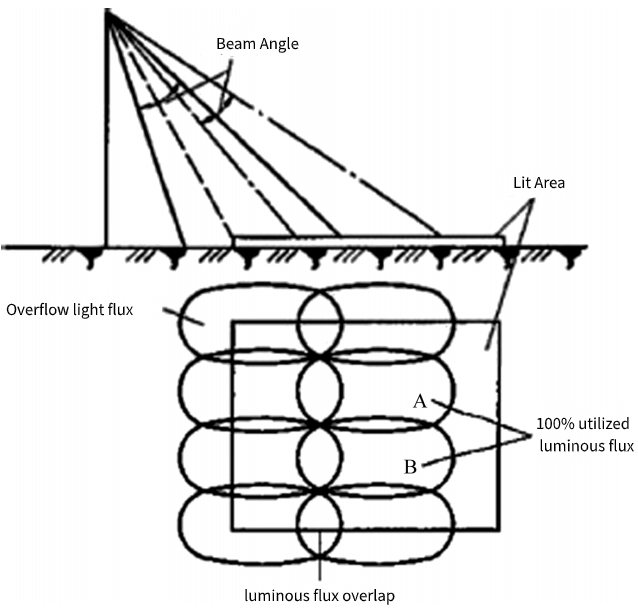
Table 1 Utilization coefficient ( U) selection chart
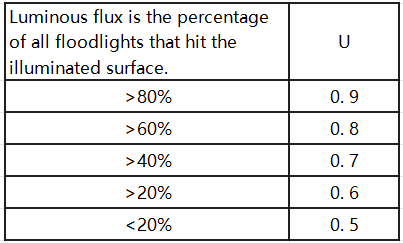
3.3 Example of Utilization Coefficient for Large Area Floodlights
As light travels, it experiences losses due to propagation, reflection, and refraction, meaning that not all the light emitted by the lamp reaches the working surface. The light that does reach the working surface is referred to as "effective light" (see Fig. 2). Based on experience, the utilization coefficient typically ranges from 0.2 to 1.0. Different lamps used in the same location, with varying light distributions, irradiation angles, and installation positions and heights, will yield different utilization coefficients. For each lighting design plan at a site, we can calculate the final utilization coefficient for that specific scheme.
Fig.2 "Effective light" of large area floodlight
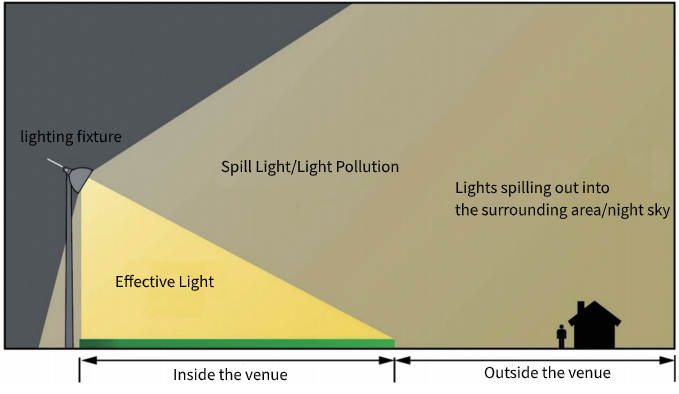
Figure 2 illustrates that as the effectiveness of light increases, the utilization coefficient also rises, leading to reduced overflow light and light pollution, which indicates a better design scheme and greater energy savings. Conversely, when light effectiveness decreases, the utilization coefficient falls, resulting in increased overflow light and light pollution, signifying a poorer design scheme and higher energy consumption. The formula for calculating the average illuminance on the illuminated surface is as follows:

In the equation, Eav denotes the average illuminance on the surface being lit, measured in lux (lx); N indicates the number of floodlights; Φ1 signifies the luminous flux of the floodlight's light source, measured in lumens (Lm); U represents the utilization coefficient; η stands for the lamp's efficiency; A refers to the area of the illuminated surface in square meters (m²); and K is the lamp maintenance factor, typically ranging from 0.70 to 0.65. (Note: The luminous flux of the lamp is calculated as the luminous flux of the light source multiplied by the lamp's efficiency.)
From formula (1), it is clear that for a given area and number of flood lights, increasing the luminous flux, utilization coefficient, lamp efficiency, and lamp maintenance factor of the floodlight light source will result in a higher average horizontal illumination on the surface. Since the luminous flux, lamp efficiency, and maintenance factor are fixed for actual lamps and cannot be enhanced, improving the utilization coefficient becomes crucial for optimizing site lighting design.
For instance, to achieve a lighting level of 300 lx on a standard 11-a-side football field (105 m × 68 m), the required effective luminous flux is calculated as follows: 105 m × 68 m × 300 lx = 2,142,000 lm. If the design incorporates 32 units of 1.500 W LED lamps, each providing a luminous flux of 160.000 lm, and assuming a maintenance factor of 0.8. the total luminous flux for this setup would be 32 × 160.000 × 0.8 = 4.096.000 lm. By dividing the effective luminous flux by the total luminous flux of the setup (2.142.000/4.096.000 = 0.52), we find the utilization coefficient for this solution is 0.52. Additionally, we can calculate the theoretical minimum number of lamps needed to achieve 300 lx illumination with this lamp type, which comes out to approximately 17 units (2.142.000/160.000/0.8 ≈ 16.73).
4. Enhance Sports Hall lighting Lighting Design
4.1 Utilize Professional Lighting Design Software
Large stadiums are expansive and intricate, making the calculation of sport hall lighting typically reliant on specialized lighting calculation software (see Figure 3). Such professional lighting design software significantly boosts the efficiency and precision of lighting design by offering realistic effect displays, accurate calculations, comprehensive optical design capabilities, precise optical simulations, multi-field integration, an extensive material library, and scattering models. This leads to improved lighting quality and energy efficiency, enhancing the utilization factor, achieving better energy savings, and minimizing light spill and pollution.
4.2 Implement Multiple Lighting Curves
Employing multiple lighting curves offers benefits such as enhanced light utilization and design precision. By selecting various lighting curves based on the distance and angle of light projection, a combination design can be created that directs more light onto the intended surface, reduces excess light escaping the venue, and increases overall light efficiency.
Fig. 3 Professional lighting design software
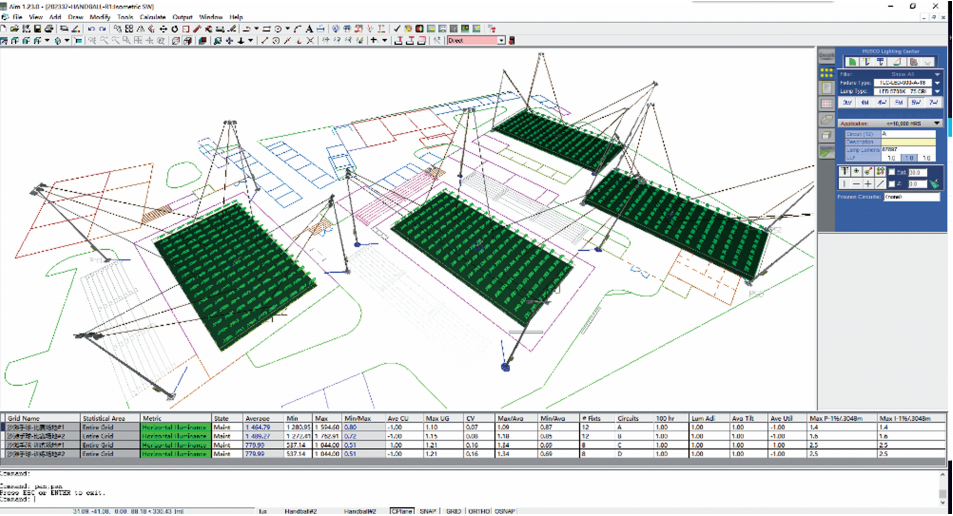
4.3 Select an Appropriate Lighting Solution
Prior to 2018. the traditional method for installing lamps involved using the center of the goal as a reference point, with the court's baseline offset by 15° to the left and right. Additionally, lighting was not permitted behind the goal or along the baseline to prevent interference with players. In contrast, the author suggests a "ring-shaped continuous lighting" approach, which disregards the previously restricted lighting areas. This method involves evenly distributing lamps along the horse trail, utilizing fixtures with improved glare control and optimizing their projection angles. This approach not only enhances glare management but also improves light uniformity and utilization throughout the venue, effectively reducing shadows. The new lighting standards set by FIFA and AFC endorse this solution, as illustrated in Figure 4.
Fig. 4 "Ring type continuous lighting" scheme
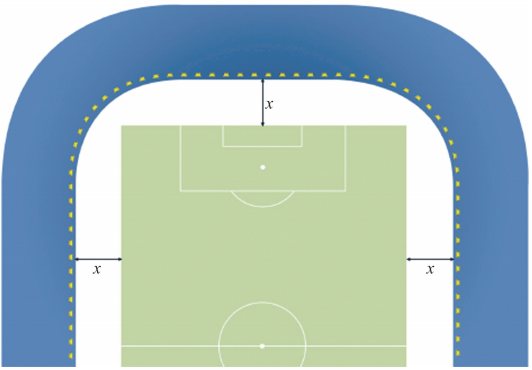
4.4 Utilizing an extensive simulation lighting laboratory to precisely measure the reflection coefficient of different venues
The benefits of employing a large-scale simulation lighting laboratory (see Figure 5) primarily consist of: efficient light sources, adaptable environmental settings, interactive teaching in real-time, the ability to conduct multiple experimental simulations, demonstration capabilities, and reductions in both time and costs.
Fig.5 Super large analog light lab
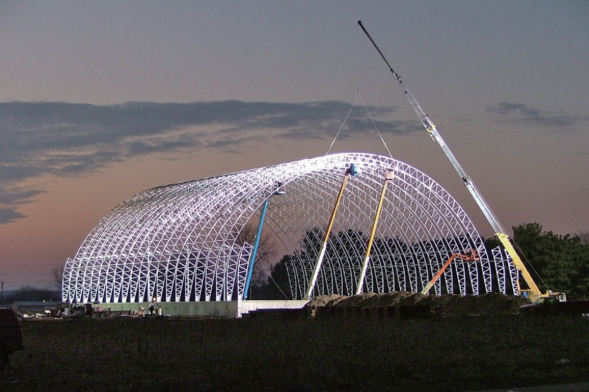
These benefits position the super large analog light laboratory as a crucial resource for contemporary education and technological research and development, particularly in the fields of optical education, scientific inquiry, and technological advancement.
4.5 Set up an effective external anti-glare cover (large size, integrated efficient optical reflector)
Implementing an effective external anti-glare cover (see Fig. 6 and Fig. 7) can minimize glare, enhance lighting quality, conserve energy, lower consumption, decrease maintenance expenses, prolong the lifespan of the light source, and improve the cost-effectiveness of economic operations. Consequently, establishing an efficient external anti-glare cover has emerged as a valuable strategy for enhancing site lighting quality, safeguarding visual health, and reducing operational costs.
Fig.6 Floodlights with high efficiency external anti-glare cover and floodlights without external anti-glare cover
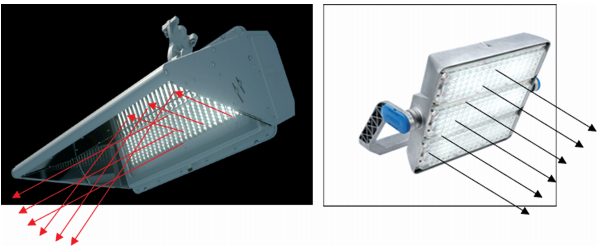
Fig.7 Comparison of overflow light with and without an effective anti-glare mask
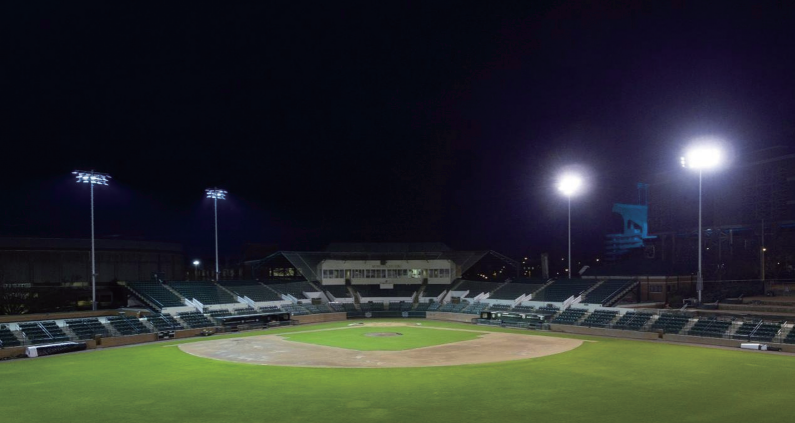
Tables 2 and 3 outline the design plans for the two sports centers. It is evident that the design featuring an "external anti-glare cover" significantly lowers energy usage in comparison to the design lacking this feature, thereby contributing effectively to the "double carbon" objective.
Table 2 National Fitness Center (2023 design plan)
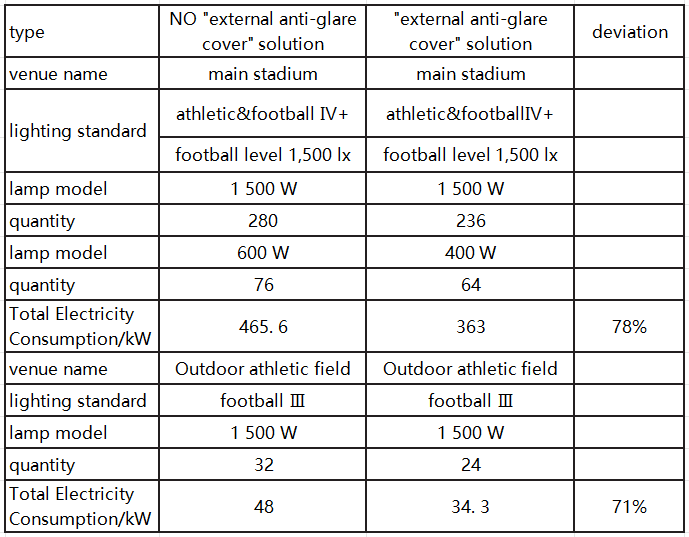
Table 3 Sports Center (2023 design)
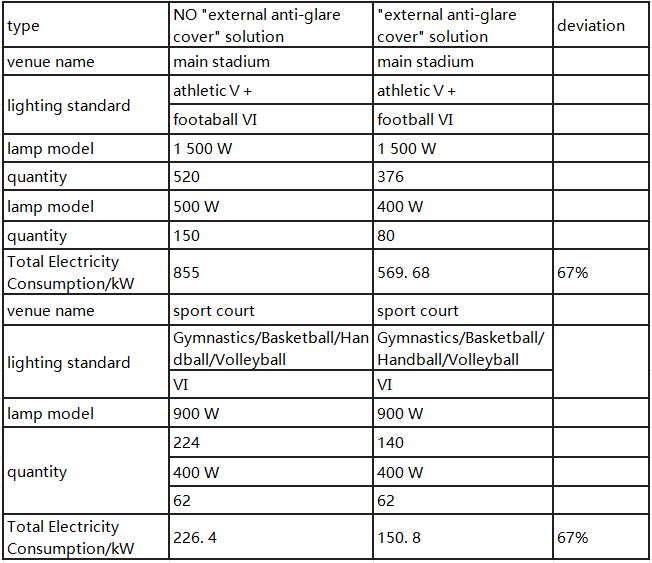
Along with the principles of functionality, safety, and aesthetics, sport hall lighting must adhere to the principles of energy efficiency and environmental sustainability. While fulfilling lighting requirements, it is essential to maximize the utilization rate of fixtures and to implement efficient, eco-friendly lighting options to minimize energy use and environmental impact.
5. Related Product
